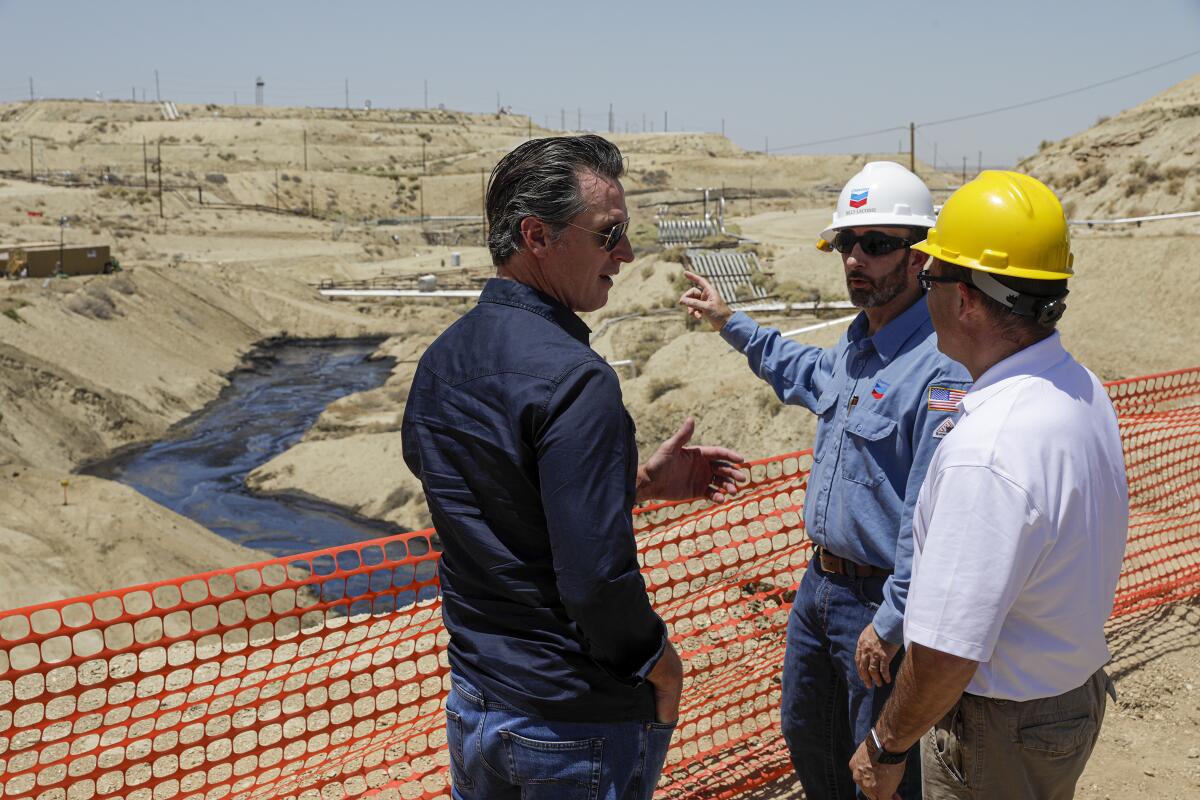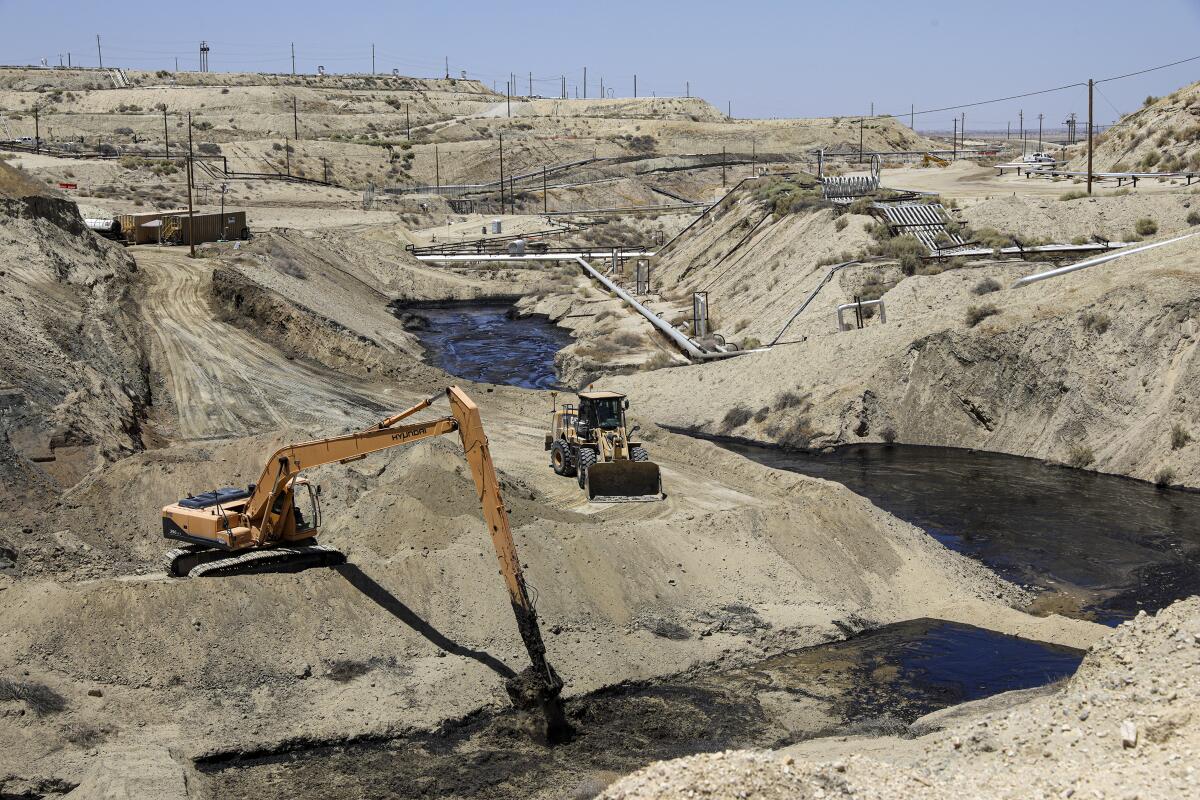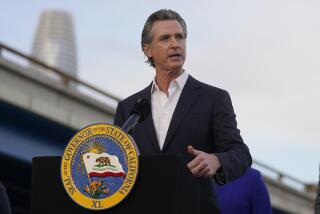Touring oil spill site, Newsom calls for greater oversight of California petroleum industry

- Share via
McKITTRICK, Calif. — Gov. Gavin Newsom, in the Central Valley on Wednesday for a firsthand look at one of the largest oil spills in California history, vowed to go beyond the state’s already aggressive efforts to curtail the use of fossil fuels and seek a long-term strategy to reduce oil production.
Newsom also signaled a sharp break with that past by criticizing existing oversight of the oil industry as too permissive. He promised to begin by retooling the state’s top oil regulatory agency, state Division of Oil, Gas and Geothermal Resources.
For the record:
1:37 p.m. July 25, 2019An earlier version of this article incorrectly stated that, according to the U.S. Energy Information Administration, California consumed 366,000 barrels of gasoline in 2017. California consumed 366 million barrels that year.
The Democratic governor made the comments after arriving in the Kern County town of McKittrick on a 100-plus-degree afternoon, just a few miles from the Chevron oil well field where roughly a million gallons spilled into a dry creek bed. Chevron officials blamed the spill — with was about two-thirds water and one-third oil — on an old well that the company recently recapped.
Although Newsom called for greater oversight of oil production, he was careful not to cast himself as an industry opponent. He made note of the local jobs sustained by petroleum production, and he praised both Chevron and state agencies for working to stem and contain the seeping liquid. He added that there was no indication that the spill threatened wildlife or aquifers that supply drinking water for local communities.
Still, he said, another major seepage is always possible.
Newsom, who took office in January, said the spill had refocused attention on California’s billion-dollar oil industry and its place in a state striving to end its dependence on fossil fuels and convert to 100% renewable energy.
“I want to focus not just on demand but supply, and that, I think, is a new approach in this state with this new administration,” the governor told The Times.
Environmental groups have been lobbying Newsom to ban new wells and curtail oil production. The leadership of the governor’s own political party has called for the immediate end of the controversial fracking method of oil extraction, a process that uses drilling and large volumes of high-pressure water to pump oil and gas from the ground.
Newsom has rebuffed those efforts, saying any action the state takes must be thoughtful, realistic and account for thousands of Californians who depend on the oil industry to make a living.
The governor, who began his visit Wednesday at McKittrick Elementary School, noted that historical pictures of oil derricks lined the school’s hallways — evidence of how engrained the petroleum industry is in the local economy.
“With respect, drive around. There are not a lot of alternative strategies for economic growth here,” Newsom said. “Before we turn off the tap, what’s the plan to take care of the folks here? What’s the plan to take care of the workers? If you can’t look people in the eye and say you have an answer to that, then I think you’re doing a disservice to people in the community, and I can’t do that.”
Newsom emphasized that $1.5 million has been set aside in the state budget, approved by the Legislature and signed by him in June, to study ways to reduce petroleum demand and production in the state, taking into consideration the effects on the economy, jobs and Californians.

Kassie Siegel of the Center for Biological Diversity said the study is a good first step but added that California cannot afford to wait to take action. Siegel and other environmental leaders want Newsom to impose a moratorium on fracking and all new oil wells.
“When you’re in a hole, the first step is to stop digging,” Siegel said. “There should be no more expansion of oil production. There’s no way to keep California safe from this industry other than phasing it out.”
Newsom said state law prohibits him from doing that by executive fiat and that legislative action would be required.
The effort to sway Newsom follows an unsuccessful campaign by environmental activists, community groups and labor unions that tried to persuade then-Gov. Jerry Brown to freeze all new oil and gas drilling during his final year in office. While praised for helping California become a world leader in combating climate change, Brown has come under attack for not reining in the state’s oil industry.
“There’s been a cozy relationship that the Brown administration and California have had with the oil industry, and I think those days are gone,” said state Sen. Bob Wieckowski (D-Fremont).
Wieckowski wrote legislation that would charge a 10% tax on every barrel of oil pumped from the ground in California to bring in some $900 million annually, part of which can be used to increase regulatory oversight of oil production, he said.
Earlier this month, Newsom fired California’s top oil industry regulator for issuing too many permits for hydraulic fracturing, as fracking is formally known. He said he intends to reshape leadership of the agency to increase regulatory oversight of the oil industry.
California is one of the nation’s top petroleum-producing — and gasoline-consuming — states, pitting an essential ingredient of the California economy and everyday lifestyles against overwhelming public sentiment for curtailing the use of fossil fuels.
In 2018, Brown and the Legislature adopted an ambitious goal to covert California to a 100%, zero-carbon electrical supply by 2045. A 2016 poll by the Public Policy Institute of California found that most likely voters in the state opposed fracking and increased oil drilling off the coast. A vast majority also favored stricter emission limits on power plants in an effort to address climate change.
Still, California is home to 26 million vehicles with internal-combustion engines, and the oil industry helps support close to 368,000 blue-collar jobs in the state, according to the Western States Petroleum Assn.
California is home to 72,000 oil-producing wells that last year produced 165.3 million barrels of oil from onshore and offshore facilities, according to the California Department of Conservation. California also consumes more gasoline than any other state — 366 million barrels in 2017, according to the U.S. Energy Information Administration.
According to the state Division of Oil, Gas and Geothermal Resources, known as DOGGR, more than 120,000 wells in the state have been plugged, the legacy of more than a century of oil drilling.
The Chevron-owned well where the spill occurred last drew oil in 2003 and was sealed with cement some time after, according to state data. It sits alongside more than 3,600 other plugged wells in the Cymric oil field in Kern County, most of which are Chevron’s.
An additional 400 wells in the field sit inactive, not producing oil and waiting to be sealed. Nearly all of the wells in the Cymric field are operated by some of the state’s biggest producers: Chevron, ExxonMobil, Shell and Sentinel Peak.
Wade Crowfoot, California secretary for natural resources, said the state is still trying to determine the cause of the spill and whether the oil company’s use of steam injection in the area was a contributing factor. State officials already have demanded all the data collected by Chevron about the spill to help with the state’s independent review of the incident.
Times staff writer Ryan Menezes contributed to this report.
More to Read
Sign up for Essential California
The most important California stories and recommendations in your inbox every morning.
You may occasionally receive promotional content from the Los Angeles Times.











